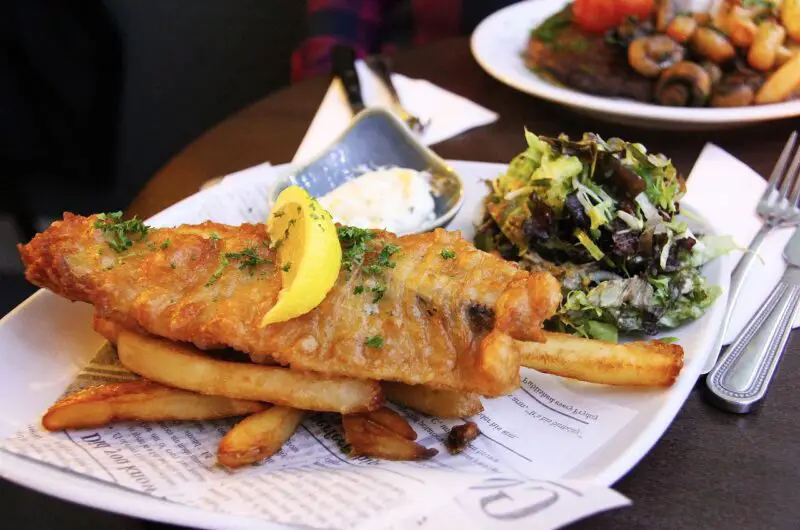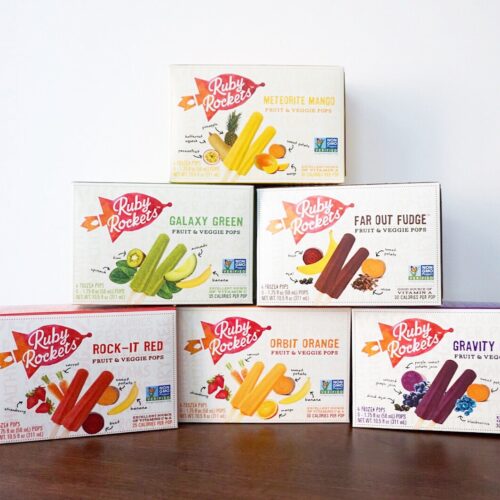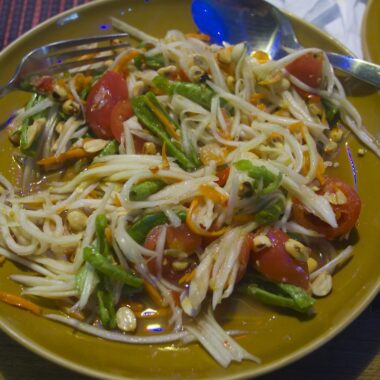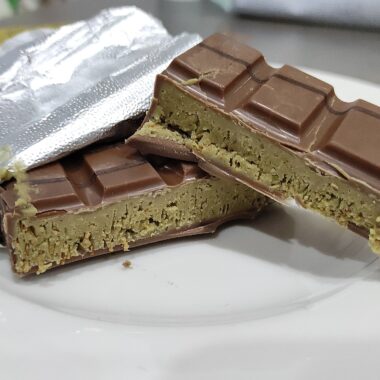As a traveler stepping onto British soil, you’re not just crossing borders—you’re diving into a culinary heritage that’s as rich and varied as the rolling hills of the Cotswolds or the rugged cliffs of Cornwall. British food often gets a bad rap, stereotyped as bland or heavy, but that’s a tired cliché. From hearty pub grub to delicate afternoon teas, the UK’s food scene is a tapestry of history, regional pride, and comfort. For anyone exploring the British Isles, tasting these traditional dishes is as essential as visiting Stonehenge or strolling through London’s Borough Market. Here’s a guide to the traditional British foods you absolutely need to try, written through the lens of a curious traveler eager to savor the soul of the UK.
The Full English Breakfast: A Morning Feast
Start your day like a true Brit with the Full English Breakfast, a plate so packed it’s practically a national institution. Picture this: you’re in a cozy café in York, the smell of sizzling bacon wafting through the air, and a steaming plate arrives with fried or poached eggs, crispy bacon, sausages, grilled tomatoes, mushrooms, fried bread or toast, black pudding, and baked beans. It’s a symphony of textures and flavors—savory, salty, and slightly sweet from the beans.
Each region tweaks it slightly; in Scotland, you might find tattie scones (potato pancakes), while in Wales, laverbread (a seaweed paste) could make an appearance.
As a traveler, the Full English is your fuel for a day of exploring. It’s not subtle, and neither is its appeal. I remember my first encounter in a greasy spoon in Manchester—greasy in the best way. The black pudding, a sausage made from blood and oats, was a revelation: earthy, slightly spicy, and nothing like I’d expected. Pro tip: pair it with a strong cup of tea (milk, no sugar, unless you want to spark a debate). If you’re in a rush, some cafés offer a “bacon butty” (a bacon sandwich), but the full experience is worth the time. Seek out a local spot—avoid tourist traps near Trafalgar Square—and dive in.
Fish and Chips: The Seaside Staple
No trip to the UK is complete without fish and chips, ideally eaten from newspaper (or paper these days) on a windy beach. This dish is Britain’s culinary ambassador: crispy, golden batter encasing flaky white fish (usually cod or haddock), served with thick-cut chips doused in malt vinegar and a sprinkle of salt. It’s simple but sublime when done right. My first taste was in Whitby, North Yorkshire, where the fish was so fresh it practically tasted of the North Sea. The crunch of the batter, the soft fish, and the tangy vinegar hit every note.
Every coastal town claims to have the best fish and chips, from Brighton to Blackpool. Inland, you’ll find chippies (fish and chip shops) on nearly every high street. Look for ones with a queue of locals—that’s a good sign. Some places offer extras like mushy peas (a vibrant green mash of marrowfat peas) or a pickled onion. If you’re feeling adventurous, try a “chip butty” (chips in a buttered roll) on the side. Wash it down with a fizzy drink like Irn-Bru in Scotland or a shandy (beer mixed with lemonade) elsewhere. It’s messy, it’s indulgent, and it’s quintessentially British.
Sunday Roast: A Ritual of Comfort
If there’s one meal that feels like a warm hug from Britain, it’s the Sunday roast. Traditionally served after church, this dish is a celebration of slow-cooked meats, seasonal vegetables, and community. You’ll find it in pubs across the country, especially on Sundays, where families gather around tables laden with roast beef, lamb, pork, or chicken, accompanied by crispy roast potatoes, Yorkshire puddings (fluffy, savory pastries), seasonal veg like carrots and parsnips, and lashings of gravy.
My first Sunday roast was in a 17th-century pub in the Lake District. The beef was pink in the middle, the Yorkshire pudding the size of my head, and the gravy rich enough to make me forget the rain outside. Each region has its spin: in Yorkshire, the puddings are king; in Cornwall, you might get a side of cauliflower cheese. Vegetarians aren’t left out—nut roasts or veggie Wellingtons are increasingly common. Pair it with a pint of local ale, and don’t skip dessert—sticky toffee pudding often follows. Book a table in advance for Sunday lunch; pubs fill up fast, and you’ll want to linger.
Pie and Mash: London’s Working-Class Classic
For a taste of old-school London, head to a pie and mash shop in the East End. This dish—minced beef or chicken pie, creamy mashed potatoes, and a parsley-infused green sauce called liquor—is pure comfort food. Born in the 19th century to feed working-class families, it’s still a staple in places like M. Manze in Bermondsey. The pie’s pastry is crisp, the filling hearty, and the liquor (don’t worry, it’s not alcoholic) adds a unique herby tang.
As a traveler, walking into a pie and mash shop feels like stepping back in time. The tiled walls, no-nonsense service, and clatter of plates create an atmosphere that’s unpretentious and welcoming. I tried it in Deptford, where the owner chatted about the shop’s history while I scooped up mash drenched in liquor. Some places serve it with jellied eels, a traditional side that’s an acquired taste (slippery, gelatinous, and very fishy). If you’re not ready for eels, stick with the pie—it’s a meal that fills both your stomach and your curiosity about London’s past.
Afternoon Tea: Elegance in Every Sip
For a quintessentially British experience, book an afternoon tea. This isn’t just a drink—it’s a ritual. Picture delicate sandwiches (cucumber, smoked salmon, or egg and cress), warm scones with clotted cream and jam, and an array of dainty cakes, all served with a pot of loose-leaf tea. It’s a tradition rooted in the 19th century, when the Duchess of Bedford needed a pick-me-up between lunch and dinner. Today, it’s a treat for special occasions or just because.
I had my first afternoon tea at a tearoom in Bath, where the scones were so fresh they crumbled at the touch. The debate over whether to put cream or jam first on your scone is serious business—Devon says cream first, Cornwall says jam. Try both and pick a side. For a splurge, go to The Ritz in London, but smaller venues in the countryside often have more charm and better value. Vegetarians and vegans are well-catered for now, with plant-based sandwiches and cakes popping up everywhere. Sip slowly, savor the moment, and feel like you’ve stepped into a Jane Austen novel.
Cornish Pasty: A Handheld History Lesson
The Cornish pasty is a portable piece of British history. This half-moon pastry, crimped along the edge, is filled with beef, potato, swede (rutabaga), and onion, baked until golden. Originally a miner’s lunch in Cornwall, it’s now a national treasure. The crimp made it easy to hold with grubby hands, and legend says miners tossed the crust to appease mine spirits. Today, you’ll find pasties everywhere, from Cornwall’s St. Ives to London’s train stations.
My first pasty was in Penzance, still warm from the bakery. The filling was peppery and satisfying, the pastry flaky yet sturdy. Look for a Protected Geographical Indication (PGI) pasty to ensure authenticity—Cornwall guards its recipe fiercely. Variations exist (chicken, veggie, even sweet versions), but purists stick to the classic. Eat it on a cliffside walk with sea views, and you’ll understand why this humble pie has endured for centuries.
Haggis: Scotland’s Bold Delicacy
In Scotland, haggis is a must-try, even if its ingredients—sheep’s heart, liver, and lungs mixed with oats and spices, cooked in a stomach—sound daunting. It’s rich, peppery, and surprisingly delicious, often served with “neeps and tatties” (mashed turnips and potatoes). I tried it at a Burns Supper in Edinburgh, where it was piped in with bagpipes and “addressed” with a Robert Burns poem. The ceremony was as memorable as the flavor.
Haggis is widely available, from pubs to fine dining spots. Vegetarians can find excellent meat-free versions. Pair it with a dram of whisky for the full Scottish experience. If you’re there on Burns Night (January 25), you’re in for a treat, but any time of year, haggis showcases Scotland’s knack for turning humble ingredients into something extraordinary.
Welsh Rarebit: Cheese with a Kick
Welsh rarebit (or rabbit, depending on who you ask) is comfort food at its finest: thick toast topped with a gooey, savory cheese sauce spiked with mustard, Worcestershire sauce, and sometimes beer. It’s like a gourmet grilled cheese but with a Welsh twist. I had it in a Cardiff pub, where the sauce was so rich it almost stole the show from the local ale.
This dish is perfect for a quick lunch or late-night snack. Some versions add a poached egg or bacon on top. Look for it in Wales, but it’s common across the UK. It’s simple, satisfying, and a reminder that British food doesn’t need to be fancy to be unforgettable.
Sticky Toffee Pudding: Sweet Perfection
For dessert, sticky toffee pudding is non-negotiable. This steamed sponge cake, made with chopped dates, is drenched in a warm toffee sauce and served with custard or ice cream. It’s sweet, sticky, and indulgent, the kind of dessert that makes you forget your diet. I had it in a Devon pub, where the sauce soaked into the sponge, creating a caramelized bliss.
Originating in the Lake District, it’s now a national favorite. Every region has its take, but the best ones are homemade, served piping hot. If you’re in a rush, supermarkets sell decent versions, but nothing beats a pub’s offering. Pair it with a cup of tea or a dessert wine for maximum decadence.
Regional Gems: From Scotch Eggs to Bara Brith
Beyond the classics, Britain’s regions offer unique dishes. Scotch eggs—hard-boiled eggs wrapped in sausage meat, breaded, and fried—are perfect pub snacks. I grabbed one in Glasgow, still warm, with a tangy mustard dip. Bara brith, a Welsh fruit bread, is lovely with butter and tea, especially in a Cardiff café. In Northern Ireland, try an Ulster fry, a variation of the Full English with soda bread and potato farls.
Don’t miss regional cheeses like Cheddar from Somerset or Stilton from Leicestershire. And if you’re in the Midlands, a Balti curry in Birmingham’s Curry Triangle is a nod to Britain’s multicultural food scene. Each bite tells a story of place and people.
Tips for Travelers
- Seek Local Spots: Avoid touristy chains. Ask locals for their favorite chippie or pub.
- Embrace Pubs: Pubs are the heart of British food culture. Look for ones with “gastropub” credentials for elevated classics.
- Try Markets: Borough Market in London or St. George’s Market in Belfast offer street food versions of these dishes.
- Be Adventurous: Don’t shy away from black pudding or haggis. You might be surprised.
- Mind the Seasons: Sunday roasts shine in winter, while afternoon tea is perfect in summer gardens.
Final Thoughts
British food is more than sustenance—it’s a journey through history, culture, and community. From the crunch of fish and chips by the sea to the warmth of a Sunday roast in a country pub, these dishes are as much about the experience as the flavor. As a traveler, diving into these foods connects you to the heart of the UK. So grab a fork, raise a cuppa, and eat your way through Britain’s culinary treasures. You won’t regret it.


















